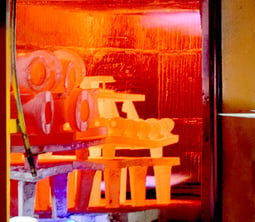Overview of Physical Properties of Metals

Physical properties are an important way of distinguishing one material from another. In the study and application of metallurgy, physical properties are often considered a broader category than mechanical properties, but not all properties overlap. Physical properties are most easily distinguished from mechanical properties by the method of testing. While mechanical properties require forces to be applied to obtain a measurement, physical properties can be measured without changing the material.
That said, physical properties do change in different environments. For example, most metals have a higher density at lower temperatures due to the principles of thermal expansion and contraction. Color and appearance, which are also physical properties, change based on a number of environmental factors.
To learn more about mechanical properties of metals, check out our blog post here.
Physical properties of metals include:
- Corrosion resistance
- Density
- Melting point
- Thermal properties
- Heat capacity
- Thermal conductivity
- Thermal expansion
- Electrical conductivity
- Magnetic properties
What Is an Alloy?
The word alloy appears throughout the Eagle Group Blog, especially here in this series. An alloy is a uniform mixture made from a combination of individual elements, when at least one of the elements is a metal. Common alloys include bronze, which is a mixture of copper (Cu) and tin (Sn). Steel is a mixture of iron (Fe) and carbon (C), and stainless steel includes other alloying agents like chromium (Cr), nickel (Ni) and manganese (Mn).
Corrosion Resistance
 Many types of corrosion can occur. Corrosion is a process in which a material is reduced to a more stable state via chemical reaction, often related to the atmosphere or service conditions. Rust, a common sight on unprotected products made of ferrous metals, is one of the most common forms of corrosion.
Many types of corrosion can occur. Corrosion is a process in which a material is reduced to a more stable state via chemical reaction, often related to the atmosphere or service conditions. Rust, a common sight on unprotected products made of ferrous metals, is one of the most common forms of corrosion.
Corrosion resistance, on the other hand, is the material's ability to resist the reaction to move toward a more stable state in its environment.
Raw aluminum, silicon, titanium and their alloys are naturally corrosion resistant due to an unreactive layer that quickly forms on their surfaces. A common alloy for many applications requiring corrosion resistance is stainless steel. Unlike carbon steel, stainless steel alloys are able to resist surface corrosion when exposed to environments that would normally cause corrosion, including wet, acidic or high heat.
Click here read our "Corrosion Resistance" blog post
Density
 The density of an object is determined by a simple formula: the object’s mass (M) divided by its volume (V). At first, the practical application of density was to determine the authenticity of gold, as in the story of the golden crown. Gold is an excellent candidate for testing density, because it is a much denser material than other metals, with an average density of 1,206 lbs. per cubic foot.
The density of an object is determined by a simple formula: the object’s mass (M) divided by its volume (V). At first, the practical application of density was to determine the authenticity of gold, as in the story of the golden crown. Gold is an excellent candidate for testing density, because it is a much denser material than other metals, with an average density of 1,206 lbs. per cubic foot.
Alloys more commonly used in manufacturing have lower densities. Steel averages around 494 lbs./ cubic foot, while stainless steel is a bit less. Titanium is about half the density of steel, and aluminum is about one-third. Practically speaking, this means that a part made of steel will weigh approximately three times more than the exact same part made of aluminum. However, steel has other advantages like hardness and strength, and so lower volumes or thicknesses of material can provide the same or better performance, comparatively.
Eagle Alloy and Eagle Precision often produce complex, thin-walled castings from different carbon and stainless steel alloys. The alloy affects the design, production process and finishing techniques used to manufacture each cast part.
Melting Point
 The melting point of a material is defined as the temperature at which it changes from solid to liquid at atmospheric pressure. Melting point can be a major factor in deciding if an alloy will be possible to use for a particular product. Different alloys have different melting point ranges, as determined by the elements of their chemical makeup. For example, an alloy with a high percentage of tin or aluminum will melt at a much lower temperature than an alloy made of mostly iron and nickel.
The melting point of a material is defined as the temperature at which it changes from solid to liquid at atmospheric pressure. Melting point can be a major factor in deciding if an alloy will be possible to use for a particular product. Different alloys have different melting point ranges, as determined by the elements of their chemical makeup. For example, an alloy with a high percentage of tin or aluminum will melt at a much lower temperature than an alloy made of mostly iron and nickel.
Melting point is an important consideration for metal manufacturers. Many casting facilities utilize sand casting methods like airset or shell mold casting because the non-metal molds can withstand higher temperatures required to melt steel. Aluminum, on the other hand, can be cast using reusable steel molds, since it has a much lower melting point than steel.
Thermal Properties
 Thermal properties include heat capacity, thermal conductivity, and thermal expansion. In manufacturing, all three properties are important factors in choosing the right alloy.
Thermal properties include heat capacity, thermal conductivity, and thermal expansion. In manufacturing, all three properties are important factors in choosing the right alloy.
- Heat capacity, also known as specific heat, is the amount of energy needed to change the temperature of a material, and is a key component of predicting casting solidification.
- Thermal conductivity is defined as the rate at which heat can be transported through a material, and one thing metals have in common is high thermal conductivity. Electrical conductivity is a different property, but proportionally correlates to thermal conductivity. Metals like copper and gold, which are known as good electrical conductors, are also good thermal conductors.
- Thermal expansion relates to the way metals expand upon heating and contract upon cooling. This property is especially important when designing tooling for metalcasting. Patterns and molds must be larger than the final part in order to account for shrinkage during cooling.
Magnetic Properties
 Magnetic properties refer to the way in which the material responds to an applied external magnetic field. This magnetic response can be classified as diamagnetic, paramagnetic, ferromagnetic, antiferromagnetic, or ferrimagnetic.
Magnetic properties refer to the way in which the material responds to an applied external magnetic field. This magnetic response can be classified as diamagnetic, paramagnetic, ferromagnetic, antiferromagnetic, or ferrimagnetic.
- Diamagnetic - repelled by magnetic fields
- Paramagnetic - shows no magnetic order
- Ferromagnetic - strongest type of magnetism
- Antiferromagnetic - may exist at sufficiently low temperatures, but vanishes at/above Néel temperature
- Ferrimagnetic - weak form of ferromagnetism
Iron is one of the most magnetic metals, and so ferrous metals (metals containing iron) like steel also exhibit degrees of magnetism--specifically ferromagnetism.
While the above properties are by no means exhaustive, they do represent many of the most important properties involved in choosing a material for metalcasting or CNC machining. At the Eagle Group, our metallurgy experts have the experience to evaluate a product's needs and based on customer input, ultimately suggest the optimal alloy for the job. We also employ an exhaustive APQP process for all new projects, which allows us to dial in exact parameters throughout the manufacturing process that lead to the best quality casting.
To learn more about metalcasting and machining processes, download our free ebook below:
Tags: Materials, Metallurgy, Metal Properties

Written by Jason Bergman
Jason Bergman is Senior Quality Engineer and Metallurgist at Eagle Alloy. He has been with the company since 2013.




